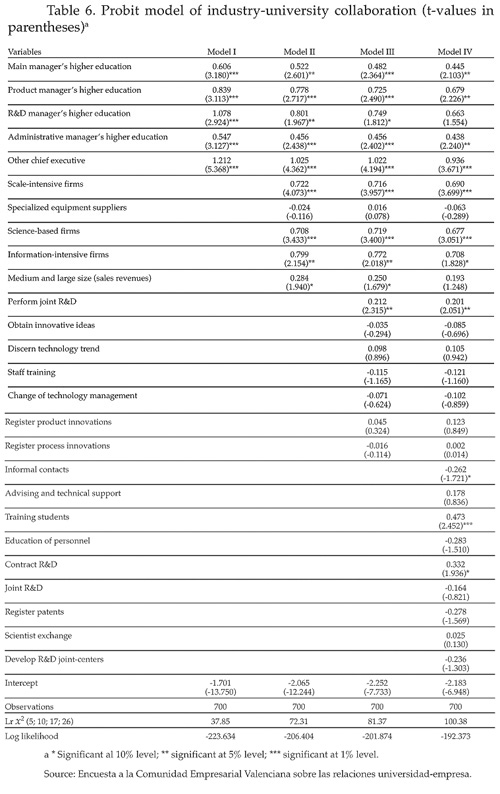
Adela García-Aracil, Ignacio Fernández de Lucio, Antonio Gutiérrez Gracia y Elena de Castro Martínez
To clarify the effects of industrial sectors, firm size and the performance of R&D activities on the industry-university interaction, we estimated an econometric model. Our dependent variable took two outcomes: (1) if the firms collaborated with universities, (0) otherwise. To reflect our discrete dependent variable, if the firm collaborated with universities or not, we used probit models under divers specifications. Thus, maximum-likelihood estimation of the models was carried out (Green, 1997). The explanatory variables were classified into four categories represented diverse elements that could influence I-U collaboration scores: educational variables from managers, industrial sector according to technological linkages, motivations for collaborating and interactive activities. To refine the effects of each explanatory variable on I-U collaboration scores, we estimated four different specifications of the probit model. The estimation results are presented in Table 6. Descriptive statistics for all these variables are reported in Appendix A.

Under the first specification (Model I), we found that the manager’s level of education had a strong influence on the performance of I-U collaboration. We split the managers according to their position in the firm, that is, main manager, product manager, R&D manager, administrative manager and other chief executive and we defined dummy variables coded 1 if managers completed higher education against those who did not complete that level of education (coded 0). Our empirical results show that managers with higher education were more likely to enhance I-U collaboration. Thus, the level of education of the managers appeared to be part of a firm’s decision in order to collaborate or not with a university. This finding was similar to observe in an academic survey (“Encuesta de la Comunidad Académica de la Comunidad Valenciana y las Relaciones Universidad-Empresa”) also carried out in Valencia region in the same period, where a vast majority of the academic researchers basically collaborated with those employers holding a higher education degree (García-Aracil et al., 2003).
The second specification (Model II) shows, as it was expected, that those firms, which were classified as science-based and information-intensive, were more likely to involve in I-U collaboration activities with respect supplier dominated firms (the omitted category). In addition, scale-intensive firms also presented a high likelihood of participating in I-U activities. This result can be explained by the strong weight of the ceramic sector in this category, one of the most relevant sectors in the Valencia economy, especially in innovation activities. On the other hand, the causal links running from I-U collaboration to firm technical change and to firm size were observed in our finding as Nelson and Winter (1982) also suggested. However, specialized equipment suppliers did not show effects on the decision of collaboration with universities. Again, personal executive education characteristics have the strongest impact.
Under the third specification (Model III), several motivations for collaborating were added as regressors. Only perfom joint R&D activities had a strong impact. Neither obtain innovative ideas, discern technology trend, staff training, change of technology management, register product innovations nor register process innovations showed significant effects on I-U collaboration. Again, managers’ level of education, industrial sector and firm size had relevant significance on a firm’s decision.
When industry-university interactive activities were included in the equation (Model IV), similar results were found for most of the previous key variables. About interactive activities, it was found that in contrast as we showed in Table 5, contract R&D activities and training students were the strongest activities among firms in order to make the decision of collaborating or not with a university, and informal contacts was not such as preferred as we expected. It could be said that employers did not considered any informal contact as an industry-university interaction, and due to the low absorptive capacity that characterized the Valencia industries, employers were interested in training students.
In this paper we have analyzed the relationship between industry-university collaboration and diverse firm-characteristic related variables for a peripheral European sample, the Spanish Mediterranean region of Valencia, of manufacturing firms according to the performance within firms of R&D activities. Discrete choice models were estimated using managers’ educational level, managers opinions about the assessment of several motivations for collaborating with universities and interactive activities most preferred as explanatory variables.
The strong relationship between managers’ qualifications and I-U collaboration is one of the most outstanding results. For instance, I-U collaboration was strongly and positively related in all cases where managers had a higher education level with respect those who did not.
The relationship between industry-university collaboration and industrial sector by technological linkages is other of the most interesting results of our study. We have found that those firms classified as informative-intensive firms were more likely to involve in I-U collaboration activities with respect supplier dominated firms. In the same direction, the match between large-sized firm and I-U collaboration was also found significant.
Variables related to firms’ motivation for collaborating with universities show a more diverse pattern. It seems that only the performance of joint R&D activities was important. Neither obtain innovation ideas, discern technology trend, staff training, change of technology management, register product innovations nor register process innovation showed significant effects on I-U collaboration.
Finally, variables related to managers opinion about most interactive-activity preferred, we have found that those firms that collaborated with universities preferred contract R&D instead of informal contacts (some level of mistrust among actors could explain this fact). On the other hand, a highly trained student was also lighted as a benefit to a firm.
Thus, Valencia region characterized as a small and open economy with predominantly small and medium-sized firm structure where their owners lacking modern business education or research traditions, based on a number of traditional industrial sector, like toys, plastics, textile, metal, furniture, ceramics and so on, but lacks telecommunications, biotechnology or other similar industries science-based, these region’s characteristics have an important influence on the performance of industry-university collaboration and R&D activities as well.